WHAT:
WHEN:
WHERE:
TICKETS:
Tickets for adults are $12 in advance and $15 at the door. Tickets for students and for ETA-20/20 Festival participants are $9.00, at the door only, and require valid ID.
Advance tickets:
and in these neighborhoods (click for map and phone number):
THE ARGENTINE TANGO
A brief description of the music and dance of the Rio de la Plata, by Patricia Paz
The origins of the Tango stem from the end of the last century, around the year 1880. What is now considered to be one of the most exquisite and deeply moving musical forms of expression began as short, catchy melodies played by improvisational musicians in the brothels of Buenos Aires, Argentina. The most popular melodies were requested frequently and in that manner they were committed to the memory of the musicians and the audience. These melodies were played in other places as well, as the local musicians worked a variety of venues to make a living.

Unfortunately there is no written music for these melodies and no way to identify the first tango dance movements or steps. Improvisational musicians and costumers were the progenitors of what would become one of the world's most popular dances. The style closest to the incipient tango music would be "Habanera Cubana" and "Tango Andaluz." The latter is the music that Spanish sailors took to Cuba, mixed with native Cuban music.
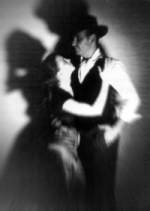
Argentine tango had its geographic roots in the area around the Rio de la Plata, the river which separates Buenos Aires from neighboring Uruguay. From there, the music and dance spread quickly; it became a musical genre, not just for lonely single men but for those with a wife and family, who also visited the brothels. Through them, the tango reached into the family anteroom. And then eventually to the public salon.
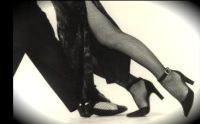
The exchange of culture was two-way, as at various points in the 19th and early 20th centuries, elements of the Vienese Waltz had traveled to Argentina and were absorbed into tango. A significant difference between European waltz styles and the Argentine tango is the physical distance between the dancing partners - in the latter case the tango features a very, very close embrace.

Thanks to the release in the 1920s of The Four Horseman of the Apocalypse starring Rudolph Valentino, the tango gained international recognition. Popularity in Spanish-speaking cultures increased also, stemming from the slightly later release (1930s?) of a film featuring the famous tango dancer Carlos Gardel and an all-Argentine cast, filmed in Hollywood, titled "El Dia Que Me Quieras".
Building on the war-time popularity of the "big band" sound and the post-World War II increase in awareness of international music and dance, the 1950s produced the "Golden Age of Tango." The tango orchestras of that era were magnificent, with lush, yet pulsating and sensuous arrangements; the music they recorded is still played today as the music of the Milongas (social dance).
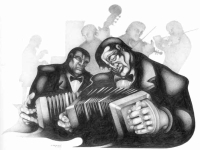
More recently, the tango has regained its world-wide importance and popularity. "The Compania de Tango Argentino" led the revival with a magnificent show that toured the world during 1980s. "Forever Tango" continued this tradition and is still playing on Broadway today. These shows served to showcase the tango "fantasia" that has entranced so many people with its beauty and elegance. Today, the United States has a rapidly growing and vibrant tango community - tango foundations and organizations with many American and Latino teachers that have embraced this dance as their life and livelihood.
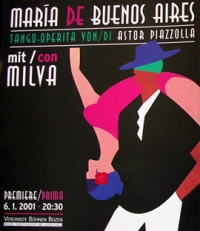
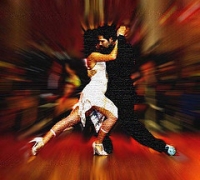
www.cincinnatitangozone.com
www.salsatangoson.com
Click here to add the CWC website to your browser Favorites List (MS-IE only)
Copyright © 2002 - 2006,
Cincinnati World Cinema

ABOUT THE FILM
"THRILLING ... DAZZLING ... A SINUOUS DELIGHT! Eyes locked, bodies tensed, moves in perfect unison, they need only display this dance's hypnotic blend of liquidity and fury, only revel in its dizzying complexity and split-second timing, to burn up the screen. TANGO offers transfixingly beautiful scenes of the dance and the wide range of emotions it conjures ... a very deserving recipient of its best foreign film Oscar nomination."
~ Janet Maslin, The New York Times
"Bold ... Seductive ... A mesmerizing experience, a smoky, lush blend of muted light and color, of intoxicating dance and the richest tango music you could ever imagine!"
~ Kevin Thomas, The Los Angeles Times
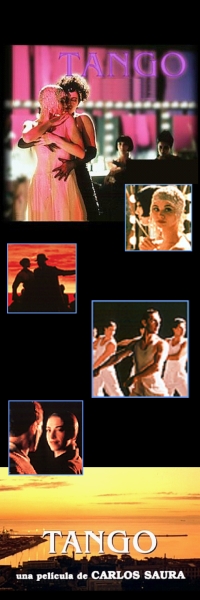 Click here to listen to the WVXU review of the film.
Click here to listen to the WVXU review of the film.
WATCH THE TRAILER
Click here for Windows Media, mid-size.
Click here for RealPlayer, mid-size, large and full-screen.
You should see "Tango" for the excellent melding of many outstanding elements - the dancing, the music, the cinematography, the lighting, the use of colors, the sets, the costumes - all of which are a result of the filmmakers' creativity and vision. In short, the film is a dazzling spectacle that conveys the symbolic aspect of the tango along with its earthiness.
"Tango, No Me Dejes Nunca" (released as "Tango" in the U.S.), brings to the big screen a transfixing portrait of a culture's ability to mirror its soul through its art. As a dance form the tango has achieved near-religious status in Spanish-speaking cultures - crossing gender, age and class lines in its universality. Combining fiction with documentary, esteemed director Carlos Saura offers a sizzling mesh of passion, sensuality, dance, music, sets, decor and costumes, with finely choreographed elements of Argentina's turbulent history.
Saura has a number of significant collaborators: Lalo Schifrin, the veteran Argentinean composer (originally Astor Piazzolla's pianist and musical advisor), wrote new tango music to go with traditional scores by Canaro, D'Arienzo and Pugliese. And tango masters Juan Carlos Copes, Carlos Rivarola and Ana Maria Steckelman created brilliant choreography, expertly executed by dozens of professional tango artists, including maestro Julio Bocca.
Highlighting the ensemble effort is Vittorio Storaro, the Oscar-winning Italian cinematographer of Last Tango in Paris, Reds, Apocalypse Now and The Last Emperor, whose accomplishment with "Tango" garnered the Gran Prix at the Cannes Film Festival for technical excellence. Storaro's contribution surpasses mere camera work - his use of theatrical and film lighting, mirrors, scrims, projected images and minimalist staging brings the camera alive with the same fluidity and grace we see on-screen from some of the world's best tango dancers. Through this visionary approach, the film rises to another level with the audience becoming a willing dance partner, caught in the passion of this homage to tango and its cultural and emotional importance.
The plot depicts the passionate struggle of a director/choreographer to mount the ultimate production of his life: a complex dance extravaganza in the heart of Buenos Aires; and also unfolds a love triangle between the male lead, Miguel Angel Sola, and accomplished dancer Cecilia Narova and talented newcomer Mia Maestro. In an interview, Director Carlos Saura said that by design the storyline is intended to sustain, but not overwhelm or compete with the musical narration. The story, with its autobiographical nuances, is adequate but not superlative, and is not the driving reason why the film was made or should be seen.
''Tango'' ... running time 112 minutes, in Color with Dolby Surround Sound; in Spanish with English subtitles; rated PG-13 for brief, implicit (but not graphic) sexual situations. In addition to winning the Gran Prix at Cannes and a Goya, the film received an Oscar nomination for best foreign film as well as eight other awards and ten nominations in numerous categories, from the Golden Globes and many prestigious film festivals.
ABOUT THE PERFORMANCE
A "Magic Evening of Tango" at the Madison Theatre will provide a unique blend of entertainment - on-screen, on-stage and on the dance floor. The doors open at 6:45 pm, and at 7:00 pm, as the audience enters the theatre and takes their seats they will encounter Patricia Paz and Michael Wizer already on-stage.
No, you haven't missed anything and we're not starting without you !! But to offer an informal introduction to the Tango and to set the stage for the film and live performances to follow, local tango artists Patricia and Michael will casually interact with the audience, talking about and demonstrating the principal elements of the tango.
At 7:30 pm we'll have brief introductory remarks and begin the film. At 9:10 pm we'll have a brief intermission and prepare for the stage show which will start around 9:15 pm and run for approximately 30 minutes.
You will enjoy tango instrumentals performed by Nick Radina and Cliff Adams and vocals by Patricia Paz, intermixed with dance interpretations by Pablo Repun and Carina Losano, performing three tango "choreos" - known as the Vals, Milonga and Tango.
Around 9:45 the dance floor will be open for dancing by all. We hope you will greet our guest artists and ask them to tango with you - in our Thursday evening version of "Dancing with the Stars !!"
ABOUT THE ARTISTS
Pablo Repun
Pablo Repun was born and raised in Buenos Aires, where the exciting and passionate dance of Argentine tango first came alive. Mr. Repun has been dancing the tango professionally, and teaching, since 1993. Some of his numerous public and private performances include "A Toast to You" with the Florida Grand Opera; Quintango and the Ars Flores Symphonic Orchestra; Motorola's Hispanic Festival; the Tango Fantasy Congress and The Argentinean Embassy in Washington, D.C.
During his extensive tango training in Buenos Aires, Pablo studied with the top professional "Masters" of Argentine tango -- Carlos Hidalgo, Gustavo Naveira, Esteban Moreno, Pepito Avellaneda, Fabian Salas, Mingo Pugliese and Roberto Herrera, to name a few. In addition to his training in tango, Pablo mastered the Graham Contemporary Dance and Parallelism Dance Technique at The National School of Dance in Buenos Aires. In Buenos Aires, Pablo taught private and group lessons in addition to workshops at universities and cultural centers. He has taken his knowledge & experience both as a teacher and performer to many parts of the world -- Brazil, Costa Rica, Ecuador, Germany and throughout the USA. His television credits include performances on programs in Brazil, Costa Rica and USA. In addtion, he has traveled with the Quintango Quintet performing throughout the U.S. and is featured on the cover of their latest Grammy-winning CD.
In 2002, Pablo moved to Miami, Florida where he teaches Argentine tango in the Miami-Ft. Lauderdale and Naples, Ft. Myers and Sarasota areas when he is not traveling to tango events in other states and abroad. He has held group classes at South Florida's most popular milonga, "The International Club of Argentine Tango" and at Miami Dade Community College. In addition to teaching and performing, Pablo was one of the organizers of the "Miami Tangothon", a tango marathon for Florida dancers. He was the Publisher and Editor of "El Milonguero Tango Magazine", the first Argentine tango magazine in Florida and he organizes tours to Buenos Aires, via "A Todo Tango", where he personally introduces his students to the birthplace of the Argentine tango. You can learn more about Pablo at his website: http://www.pablorepuntango.com
Carina Rosario Losano
Carina Losano is a native of Buenos Aires and has studied many forms of dance, including ballet, contemporary, modern-jazz, flamenco, and salsa, but she is internationally recognized for her mastery of tango. Carina trained with many of the great Argentine tango masters such as Juan Carlos Copes, Eduardo Arquimbau, Pepito Avellaneda, Gloria and Rodolfo Dinzels, Carlos Rivarola, Gustavo Naveria, Fabian Salas, and Graciela Gonzales and taught students from all over the world at the revered Confiteria Ideal in Buenos Aires before moving to the US.
To deepen her understanding of the history and structure of tango, Carina took classes at the Tango University of Buenos Aires on the theory and interpretation of tango music, tango style and technique, and tango poetry. She was appointed Cultural Ambassador for Argentine Tango by the Secretary of Culture of Buenos Aires in 2000 and now serves as the official tango instructor of the Argentine Embassy in Washington, DC.
Carina is an accomplished choreographer as well as performer and instructor, and her credits include teaching Madonna tango technique for her role in the film Evita, and co-choreographing the Pepsi commercial starring Shakira that was aired nationally throughout the U.S during the 2003 Academy Awards. Her unique combination of technical skills as a dancer and interpersonal skills as an instructor have led international cruise lines to engage Carina as a guest instructor on cruises to several continents and numerous countries, including Argentina, Brazil, Croatia, Greece, Italy, Mexico, Puerto Rico, Turkey and Uruguay.
Carina's skill as a dancer - she has been dancing since the age of three - and teacher has been acknowledged with numerous awards and accolades, including the 'Golden Obelisk', 'Teacher of Milongueros', 'Young Generation of Milongueros', and 'Dedication to Tango', which was awarded by Juan Carlos Copes. She also was awarded First Prize in the 'Championship Hugo del Carril' in 1997 and for three consecutive years represented 'Solo Tango TV' in the International Exposition of the Cable Industry. Other public appearance include performing at the presidential inauguration for George W. Bush, performing the Argentine Tango at the Kennedy Center in Washington, DC., the Argentine Embassy in Washington, and for the Organization of American States.
As an instructor, Carina teaches a style of tango, which is elegant and dynamic, while at the same time relaxed, comfortable, enjoyable, and accessible to everyone. Her natural ability and her training with some of the greatest masters from Argentina give her a unique capacity to imbue her students with a deep feeling for the subtle nuances of tango. Under her guidance, students realize a new feeling for music and movement, and they come to enjoy the sensations, which have made tango a seductive art for generations.
Patricia Paz
Patricia Paz is a native of Argentina, growing up in Buenos Aires. With a degree in Physical Education, she is also qualified as a Folk and Native Dances Professor from the Instituto Nacional Superior de Folklore.
In 1985 Patricia began Folk Dances Fusion Workshop with Beatriz Durante at the University of Buenos Aires. One year later year she became a member of the Uballet, " Ballet de Tango y Folklore de la Universidad de Buenos Aires". With this troupe she toured Brazil in 1991, and France in 1993. As a singer, she performed with the Musical Troupe at the Instituto Superior de Arte Folklorico while she was a student there. In 1987 she started teaching workshops and performing choreographies throughout Argentina with Ruben Suares, director and choreographer of the Instituto de Arte Folklorico. In Buenos Aries, she taught in her own studio and also for other organizations.
Patricia has been active in the local arts - presenting a tango show "Tango, Poetry and Dance in the Same Scene" at the University of Cincinnati, and she also taught tango for the Cincinnati Argentine Tango Society at the University YMCA. Between 1995 and 2000 she traveled between the US and Argentina to teach workshops and private lessons.
In 1996, Patricia continued her formal voice training through singing classes with Marga Grajer and in 1998, she co-wrote and performed in a Tango concert "Maldito Rimmel" with Argentine tango songwriter Marcela Bublik. Patricia produced her first CD "Improvisando" in 1999. More recently, she has served as the Artistic Director of the Silver River Arts Project, a non-profit educational group organized for the promotion of Argentine Art and Culture. In that capacity, she performed in the tango production "Tango Des-Parada" which Silver River co-sponsored with the Cincinnati Argentine Tango Society. Patricia currently teaches regular weekly classes and sponsors special workshops by visiting Master instructors throughout the year.
Michael Wizer
I began dancing just by chance about 14 years ago. I fell in love with the music and the possibility of moving in such a slow and romantic way with a woman, one I found desirable. I would fall in love when I danced. And I longed to be able to move in more and more beautiful, graceful, and musical ways. I found teachers from Buenos Aires in New York City where I traveled regularly to take lessons. Soon after beginning I would return to my home, Pittsburgh at the time, to teach beginning students. I have taught continuously since, playing a central role in developing dance communities in Pittsburgh, Lexington, and Cincinnati. Now many years have passed. I still love to dance and to teach, and continue to study. The tango is so deep musically, culturally, and emotionally, that I see no end to my search and my love.
Nick Radina
Nick has been performing Latin music professionally in Cincinnati for over 10 years and currently appears with the Latin group Tropicoso as their "Timbalero," aka percussionist, playing two small brass drums and assorted cowbells. He also performs with the local "mambo maniacs" Salsa Caliente.
In addition to the larger Latin groups, Nick has his own small group, ZUMBA, which focuses on traditional classic Cuban music. His specialty with this group is the Puerto Rican cuatro, a ten-string guitar. Nick is committed to the Latino community and is one of the founding partners in CincyLatino, which actively promotes Latino culture in Greater Cincinnati.
Cliff Adams
Cliff Adams studied classical and jazz music at the University of Cincinnati from childhood and through college. Cliff plays in a wide variety of traditional and contemporary jazz groups and appears solo on occasion. He is a member of the explosive band, Salsa Caliente, and is also the leader of his own Latin-based band, Azucar, recently featured at the NKU Latino Arts Festival.
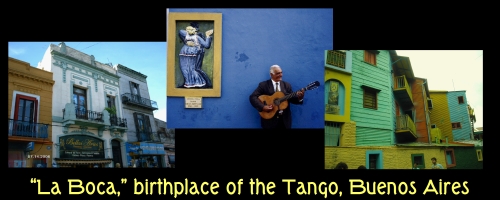
~ Janet Maslin, The New York Times
~ Kevin Thomas, The Los Angeles Times
 Click here to listen to the WVXU review of the film.
Click here to listen to the WVXU review of the film.
WATCH THE TRAILER
Click here for Windows Media, mid-size.
Click here for RealPlayer, mid-size, large and full-screen.
You should see "Tango" for the excellent melding of many outstanding elements - the dancing, the music, the cinematography, the lighting, the use of colors, the sets, the costumes - all of which are a result of the filmmakers' creativity and vision. In short, the film is a dazzling spectacle that conveys the symbolic aspect of the tango along with its earthiness.
"Tango, No Me Dejes Nunca" (released as "Tango" in the U.S.), brings to the big screen a transfixing portrait of a culture's ability to mirror its soul through its art. As a dance form the tango has achieved near-religious status in Spanish-speaking cultures - crossing gender, age and class lines in its universality. Combining fiction with documentary, esteemed director Carlos Saura offers a sizzling mesh of passion, sensuality, dance, music, sets, decor and costumes, with finely choreographed elements of Argentina's turbulent history.
Saura has a number of significant collaborators: Lalo Schifrin, the veteran Argentinean composer (originally Astor Piazzolla's pianist and musical advisor), wrote new tango music to go with traditional scores by Canaro, D'Arienzo and Pugliese. And tango masters Juan Carlos Copes, Carlos Rivarola and Ana Maria Steckelman created brilliant choreography, expertly executed by dozens of professional tango artists, including maestro Julio Bocca.
Highlighting the ensemble effort is Vittorio Storaro, the Oscar-winning Italian cinematographer of Last Tango in Paris, Reds, Apocalypse Now and The Last Emperor, whose accomplishment with "Tango" garnered the Gran Prix at the Cannes Film Festival for technical excellence. Storaro's contribution surpasses mere camera work - his use of theatrical and film lighting, mirrors, scrims, projected images and minimalist staging brings the camera alive with the same fluidity and grace we see on-screen from some of the world's best tango dancers. Through this visionary approach, the film rises to another level with the audience becoming a willing dance partner, caught in the passion of this homage to tango and its cultural and emotional importance.
The plot depicts the passionate struggle of a director/choreographer to mount the ultimate production of his life: a complex dance extravaganza in the heart of Buenos Aires; and also unfolds a love triangle between the male lead, Miguel Angel Sola, and accomplished dancer Cecilia Narova and talented newcomer Mia Maestro. In an interview, Director Carlos Saura said that by design the storyline is intended to sustain, but not overwhelm or compete with the musical narration. The story, with its autobiographical nuances, is adequate but not superlative, and is not the driving reason why the film was made or should be seen.
''Tango'' ... running time 112 minutes, in Color with Dolby Surround Sound; in Spanish with English subtitles; rated PG-13 for brief, implicit (but not graphic) sexual situations. In addition to winning the Gran Prix at Cannes and a Goya, the film received an Oscar nomination for best foreign film as well as eight other awards and ten nominations in numerous categories, from the Golden Globes and many prestigious film festivals.
ABOUT THE PERFORMANCE
A "Magic Evening of Tango" at the Madison Theatre will provide a unique blend of entertainment - on-screen, on-stage and on the dance floor. The doors open at 6:45 pm, and at 7:00 pm, as the audience enters the theatre and takes their seats they will encounter Patricia Paz and Michael Wizer already on-stage.
No, you haven't missed anything and we're not starting without you !! But to offer an informal introduction to the Tango and to set the stage for the film and live performances to follow, local tango artists Patricia and Michael will casually interact with the audience, talking about and demonstrating the principal elements of the tango.
At 7:30 pm we'll have brief introductory remarks and begin the film. At 9:10 pm we'll have a brief intermission and prepare for the stage show which will start around 9:15 pm and run for approximately 30 minutes.
You will enjoy tango instrumentals performed by Nick Radina and Cliff Adams and vocals by Patricia Paz, intermixed with dance interpretations by Pablo Repun and Carina Losano, performing three tango "choreos" - known as the Vals, Milonga and Tango.
Around 9:45 the dance floor will be open for dancing by all. We hope you will greet our guest artists and ask them to tango with you - in our Thursday evening version of "Dancing with the Stars !!"
ABOUT THE ARTISTS

Pablo Repun
Pablo Repun was born and raised in Buenos Aires, where the exciting and passionate dance of Argentine tango first came alive. Mr. Repun has been dancing the tango professionally, and teaching, since 1993. Some of his numerous public and private performances include "A Toast to You" with the Florida Grand Opera; Quintango and the Ars Flores Symphonic Orchestra; Motorola's Hispanic Festival; the Tango Fantasy Congress and The Argentinean Embassy in Washington, D.C.
During his extensive tango training in Buenos Aires, Pablo studied with the top professional "Masters" of Argentine tango -- Carlos Hidalgo, Gustavo Naveira, Esteban Moreno, Pepito Avellaneda, Fabian Salas, Mingo Pugliese and Roberto Herrera, to name a few. In addition to his training in tango, Pablo mastered the Graham Contemporary Dance and Parallelism Dance Technique at The National School of Dance in Buenos Aires. In Buenos Aires, Pablo taught private and group lessons in addition to workshops at universities and cultural centers. He has taken his knowledge & experience both as a teacher and performer to many parts of the world -- Brazil, Costa Rica, Ecuador, Germany and throughout the USA. His television credits include performances on programs in Brazil, Costa Rica and USA. In addtion, he has traveled with the Quintango Quintet performing throughout the U.S. and is featured on the cover of their latest Grammy-winning CD.
In 2002, Pablo moved to Miami, Florida where he teaches Argentine tango in the Miami-Ft. Lauderdale and Naples, Ft. Myers and Sarasota areas when he is not traveling to tango events in other states and abroad. He has held group classes at South Florida's most popular milonga, "The International Club of Argentine Tango" and at Miami Dade Community College. In addition to teaching and performing, Pablo was one of the organizers of the "Miami Tangothon", a tango marathon for Florida dancers. He was the Publisher and Editor of "El Milonguero Tango Magazine", the first Argentine tango magazine in Florida and he organizes tours to Buenos Aires, via "A Todo Tango", where he personally introduces his students to the birthplace of the Argentine tango. You can learn more about Pablo at his website: http://www.pablorepuntango.com
Carina Rosario Losano
Carina Losano is a native of Buenos Aires and has studied many forms of dance, including ballet, contemporary, modern-jazz, flamenco, and salsa, but she is internationally recognized for her mastery of tango. Carina trained with many of the great Argentine tango masters such as Juan Carlos Copes, Eduardo Arquimbau, Pepito Avellaneda, Gloria and Rodolfo Dinzels, Carlos Rivarola, Gustavo Naveria, Fabian Salas, and Graciela Gonzales and taught students from all over the world at the revered Confiteria Ideal in Buenos Aires before moving to the US.
To deepen her understanding of the history and structure of tango, Carina took classes at the Tango University of Buenos Aires on the theory and interpretation of tango music, tango style and technique, and tango poetry. She was appointed Cultural Ambassador for Argentine Tango by the Secretary of Culture of Buenos Aires in 2000 and now serves as the official tango instructor of the Argentine Embassy in Washington, DC.
Carina is an accomplished choreographer as well as performer and instructor, and her credits include teaching Madonna tango technique for her role in the film Evita, and co-choreographing the Pepsi commercial starring Shakira that was aired nationally throughout the U.S during the 2003 Academy Awards. Her unique combination of technical skills as a dancer and interpersonal skills as an instructor have led international cruise lines to engage Carina as a guest instructor on cruises to several continents and numerous countries, including Argentina, Brazil, Croatia, Greece, Italy, Mexico, Puerto Rico, Turkey and Uruguay.
Carina's skill as a dancer - she has been dancing since the age of three - and teacher has been acknowledged with numerous awards and accolades, including the 'Golden Obelisk', 'Teacher of Milongueros', 'Young Generation of Milongueros', and 'Dedication to Tango', which was awarded by Juan Carlos Copes. She also was awarded First Prize in the 'Championship Hugo del Carril' in 1997 and for three consecutive years represented 'Solo Tango TV' in the International Exposition of the Cable Industry. Other public appearance include performing at the presidential inauguration for George W. Bush, performing the Argentine Tango at the Kennedy Center in Washington, DC., the Argentine Embassy in Washington, and for the Organization of American States.
As an instructor, Carina teaches a style of tango, which is elegant and dynamic, while at the same time relaxed, comfortable, enjoyable, and accessible to everyone. Her natural ability and her training with some of the greatest masters from Argentina give her a unique capacity to imbue her students with a deep feeling for the subtle nuances of tango. Under her guidance, students realize a new feeling for music and movement, and they come to enjoy the sensations, which have made tango a seductive art for generations.
Patricia Paz
Patricia Paz is a native of Argentina, growing up in Buenos Aires. With a degree in Physical Education, she is also qualified as a Folk and Native Dances Professor from the Instituto Nacional Superior de Folklore.
In 1985 Patricia began Folk Dances Fusion Workshop with Beatriz Durante at the University of Buenos Aires. One year later year she became a member of the Uballet, " Ballet de Tango y Folklore de la Universidad de Buenos Aires". With this troupe she toured Brazil in 1991, and France in 1993. As a singer, she performed with the Musical Troupe at the Instituto Superior de Arte Folklorico while she was a student there. In 1987 she started teaching workshops and performing choreographies throughout Argentina with Ruben Suares, director and choreographer of the Instituto de Arte Folklorico. In Buenos Aries, she taught in her own studio and also for other organizations.
Patricia has been active in the local arts - presenting a tango show "Tango, Poetry and Dance in the Same Scene" at the University of Cincinnati, and she also taught tango for the Cincinnati Argentine Tango Society at the University YMCA. Between 1995 and 2000 she traveled between the US and Argentina to teach workshops and private lessons.
In 1996, Patricia continued her formal voice training through singing classes with Marga Grajer and in 1998, she co-wrote and performed in a Tango concert "Maldito Rimmel" with Argentine tango songwriter Marcela Bublik. Patricia produced her first CD "Improvisando" in 1999. More recently, she has served as the Artistic Director of the Silver River Arts Project, a non-profit educational group organized for the promotion of Argentine Art and Culture. In that capacity, she performed in the tango production "Tango Des-Parada" which Silver River co-sponsored with the Cincinnati Argentine Tango Society. Patricia currently teaches regular weekly classes and sponsors special workshops by visiting Master instructors throughout the year.
Michael Wizer
I began dancing just by chance about 14 years ago. I fell in love with the music and the possibility of moving in such a slow and romantic way with a woman, one I found desirable. I would fall in love when I danced. And I longed to be able to move in more and more beautiful, graceful, and musical ways. I found teachers from Buenos Aires in New York City where I traveled regularly to take lessons. Soon after beginning I would return to my home, Pittsburgh at the time, to teach beginning students. I have taught continuously since, playing a central role in developing dance communities in Pittsburgh, Lexington, and Cincinnati. Now many years have passed. I still love to dance and to teach, and continue to study. The tango is so deep musically, culturally, and emotionally, that I see no end to my search and my love.
Nick Radina
Nick has been performing Latin music professionally in Cincinnati for over 10 years and currently appears with the Latin group Tropicoso as their "Timbalero," aka percussionist, playing two small brass drums and assorted cowbells. He also performs with the local "mambo maniacs" Salsa Caliente.
In addition to the larger Latin groups, Nick has his own small group, ZUMBA, which focuses on traditional classic Cuban music. His specialty with this group is the Puerto Rican cuatro, a ten-string guitar. Nick is committed to the Latino community and is one of the founding partners in CincyLatino, which actively promotes Latino culture in Greater Cincinnati.
Cliff Adams
Cliff Adams studied classical and jazz music at the University of Cincinnati from childhood and through college. Cliff plays in a wide variety of traditional and contemporary jazz groups and appears solo on occasion. He is a member of the explosive band, Salsa Caliente, and is also the leader of his own Latin-based band, Azucar, recently featured at the NKU Latino Arts Festival.
